The aim of our numerical studies is the understanding of fundamental mechanisms in plasma physics. In the same time, the knowledge obtained by modelling and simulations proves to be of great help for the optimization of different plasma reactors or for the design of new applications. Our research is focused on magnetized plasmas, mainly magnetron discharges. On this subject, we have a long-standing collaboration with Laboratoire de Physique des Gaz et des Plasmas (LPGP), Orsay, France.
2D fluid model for DC magnetron discharge
A two-dimensional axisymmetric (r, z) time-dependent fluid model was developed to describe a DC planar magnetron discharge. Numerical calculations were performed both for Ar as well as for Ar/O2 gas mixture. The transport of the charged species (electrons and ions) is obtained by solving the first three moments of the Boltzmann equation: continuity, momentum transfer and mean energy transfer (the last one only for electrons), coupled with the Poisson equation. The neutral species were treated using the multi-component diffusion technique. Two-dimensional distributions of plasma parameters, such as plasma potential, densities and fluxes of the charged/neutral particles can be obtained from the model.
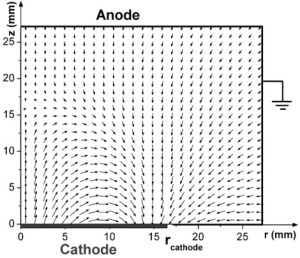
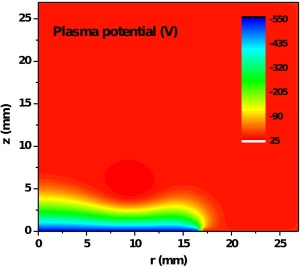
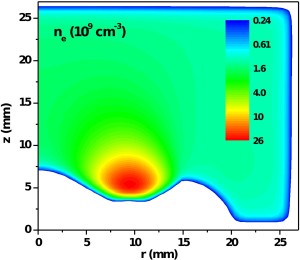
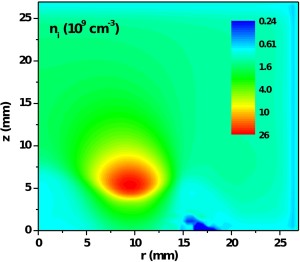 Simulation box with magnetic field map and 2D maps of plasma potential, electron (ne) and ion (ni) density, in Ar at 20 mTorr and 550 V discharge voltage
Simulation box with magnetic field map and 2D maps of plasma potential, electron (ne) and ion (ni) density, in Ar at 20 mTorr and 550 V discharge voltage
2D PIC-MCC simulation for HiPIMS
High Power Impulse Magnetron Sputtering (HiPIMS) is a very powerful tool for thin films deposition and coatings. Plasma in a HiPIMS reactor is simulated using a two dimensional (2D) Particle-in-Cell Monte Carlo Collision (PIC-MCC) code. The movement of the charged particles is followed in 3D coordinate and 3D velocity space, but the position of the particles is stored by projection on a plane (2D). The collisions are treated by Monte Carlo approach. The evolution of plasma parameters, such as elctron/ion density, plasma potential and electron energy distribution function (eedf), are followed in time during a discharge pulse.

Temporal evolution of electron (ne) and ion (ni) density over 3 s in HiPIMS – logarithmic scale, corresponding to the cathode voltage pulse shown below (Ar – 0.7 Pa)
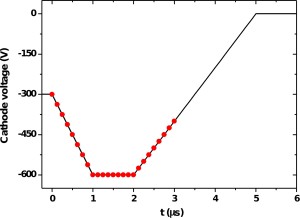
A posteriori 3D Monte Carlo simulations
A fully 3D Monte Carlo (MC) code is used to investigate the electron transport in magnetron discharges. We called this technique a posteriori MC because it uses, as input parameter, the electric field computed self-consistently by a 2D PIC-MCC simulation. The technique was used to obtain electron transport coefficients (diffusion coefficient and drift velocity) in the magnetic trap of a magnetron cathode as well as to explain the formation and development of azimuthally rotating dense plasma structures in magnetron reactors, the so-called ‘spokes’.